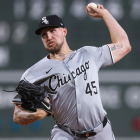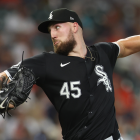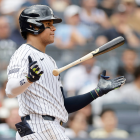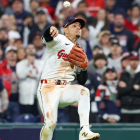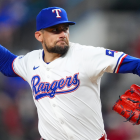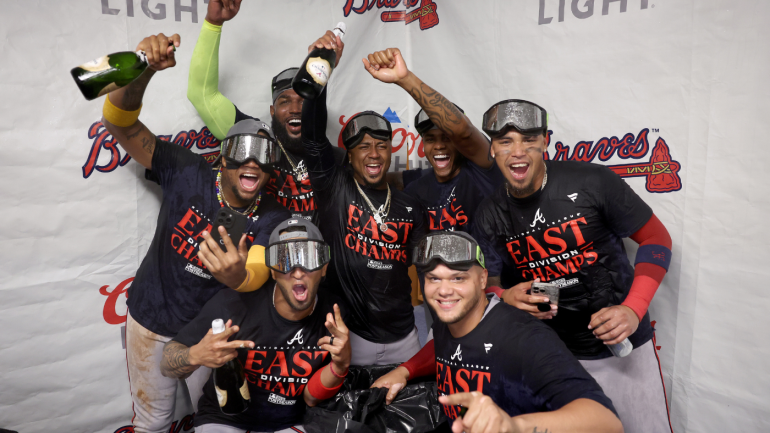
The Atlanta Braves clinched their sixth consecutive National League East crown on Wednesday night with a 4-1 win over the Philadelphia Phillies at Citizens Bank Park (box score). Austin Riley launched a two-run home run in the first to give the Braves an early lead and help them tie some history:
Braves 3B Austin Riley has hit his 35th HR of the season tonight vs the Phillies.
— ESPN Stats & Info (@ESPNStatsInfo) September 13, 2023
He is the 3rd Braves player with 35 HR this season - which is tied for the most players with 35 HR on 1 team in a season in MLB history. pic.twitter.com/oBWh5vfRW5
From there, Atlanta benefitted from Cy Young Award candidate Spencer Strider's latest strong showing. Strider threw seven innings, surrendering a run on four hits and two walks. He struck out nine batters. The Braves, in turn, became the first MLB team this season to lock up their division.
Preseason predictions about the NL East being more competitive this season proved incorrect. The Phillies have still fielded a playoff-caliber team, and the Miami Marlins might sneak into the tournament as well. Neither club was in the same class as the Braves. Ditto for the New York Mets, who reached for the eject button at the trade deadline after their splashy veteran additions failed to produce better results.
The Braves now are primed to enter the postseason with home-field advantage throughout at least the NL side of the bracket and as the betting favorites to win it all. They'll be in pursuit of their second World Series title in three years, having defeated the Houston Astros in six games in 2021 to lift their first championship trophy since 1995.
These Braves are not the same as those Braves. In fact, only four players rank in the top 10 of plate appearances on both squads. World Series MVP Jorge Soler is with the Marlins, having left that winter through free agency. Franchise mainstays Freddie Freeman (Dodgers) and Dansby Swanson (Cubs) have also since departed to join other NL contenders. None of the four pitchers who contributed the highest Win Probability Added during the World Series -- Luke Jackson, Ian Anderson, Will Smith, and Tyler Matzek -- will throw a pitch in this year's playoffs for the Braves.
It's been said that no person ever steps in the same river twice, for both they and the river change. The same is true for baseball teams and the World Series trophy. Even so, the Braves have found a way to remain dominant. How have they pulled it off? Here are three aspects of Atlanta's sustained excellence.
1. Shrewd drafting
You won't find these Braves near the top of any public-facing organizational farm system rankings. They do have some interesting youngsters on the rise (first-rounder Hurston Waldrep will be a steal if he can develop fringe-average control and infielder Ignacio Alvarez is tearing up High-A), but years of fast-tracking their best prospects and trading way substantive organizational depth has left them without the kind of established system that tends to rank highly. As such, it's easy to miss that the Braves' scouting department has been the millpond that has empowered the club's proverbial windmill to function.
To demonstrate the point, let's survey some of the notable draft picks made by Dana Brown (now the Houston Astros general manager) and scouting director Ronit Shah over a three-year period from 2019-21:
2019: The Braves used their two first-round selections to land catcher Shea Langeliers (No. 9) and infielder Braden Shewmake (No. 21). Langeliers, along with 16th-round righty Joey Estes, was part of the package sent out for first baseman and 50-plus home run slugger Matt Olson. The Braves struck paydirt later on in the class by taking center fielder Michael Harris II with the 98th pick. Right-hander Darius Vines (No. 217) and infielder Vaughn Grissom (No. 337) should continue to contribute at the big-league level. Bryce Ball, the 727th pick in the draft, was traded for rental outfielder Joc Pederson. Pederson played a big role in that 2021 title run.
2020: The Braves had four picks in the pandemic-shortened draft. They made them count. Three of their selections -- lefty Jared Shuster (No. 25) and righties Spencer Strider (No. 126) and Bryce Elder (No .156) -- have spent time in this season's big-league rotation. Strider might even end up winning the NL Cy Young Award. Landing three legitimate big-league starters, two of whom are having safely above-average seasons, with one top-100 pick is deft work.
2021: The Braves again used their first-round pick on a collegiate arm, this time popping Ryan Cusick at No. 24. They've since shipped him off to Oakland as part of the Olson deal. Second-rounder Spencer Schwellenbach looked solid this year in a return from Tommy John surgery. The Braves may have uncovered another gem when they picked big right-hander AJ Smith-Shawver at No. 217. They also took a big-league contributor at No. 96 (Dylan Dodd), as well as pieces of trades for reliever Joe Jiménez and a compensatory pick (that ended up being JR Ritchie) at picks No. 187 (Justin-Henry Malloy) and 367 (Andrew Hoffman).
To recap, Brown and Shah landed an ace (Strider), a star outfielder (Harris), and several other big-league contributors (including Elder and Grissom), as well as enough enticing players to fuel the Olson and Sean Murphy trades, among others. That's in a three-year stretch where they had one top-20 pick. That's some mighty, mighty fine work.
2. Lopsided trades with the A's
Speaking of Olson and Murphy, the Braves should send Athletics owner John Fisher a gift bag. The financial restraints Fisher placed upon his own front office allowed Atlanta to airlift two high-quality position players out of town for laughable returns. Here's a combined breakdown of the deals (do note the Braves also sent players to the Brewers as part of the Murphy trade):
- Braves receive: 1B Matt Olson and C Sean Murphy
- Athletics receive: RHP Ryan Cusick, RHP Joey Estes, C Shea Langeliers, CF Cristian Pache, RHP Royber Salinas, LHP Kyle Muller, C Manny Piña, and RHP Freddy Tarnok
Olson and Murphy have combined for roughly 10 Wins Above Replacement, according to Baseball-Reference's estimates. Both made this year's All-Star Game, and both seem certain to receive Most Valuable Player Award consideration, even if Murphy's comes in the form of a down-ballot vote.
On the A's side of the ledger … well, it's not pretty. Langeliers looks like he's better served as a reserve; Muller had an abysmal run in the majors earlier this season; Tarnok is trying to establish himself as a big-league reliever at present; Pache and Piña have already departed the organization; and Cusick, Estes, and Salinas are each sporting ERAs over 5.00 at their respective minor-league levels. We warned you that it wasn't pretty.
The Braves, by the way, have since signed Olson and Murphy to long-term extensions worth at least $241 million combined.
3. Pre-existing core
We noted in the introduction that the Braves have undergone some changes since their championship parade. There's a tendency in these situations to focus on the add-ons and not what was already in place. (Hey, guilty.) We think it's worth stressing that, while they've since buttressed their core through smart trades and drafts, they already had reason to believe their future was in good hands.
Outfielder Ronald Acuña Jr. (sidelined by injury for that entire postseason run), third baseman Austin Riley, and second baseman Ozzie Albies were all in their age-24 seasons or younger when they lifted the World Series trophy. Lefty Max Fried had just wrapped up his third full season in the majors. Righty Kyle Wright (who has missed most of this season due to a shoulder injury) hadn't yet corrected his course. And so on.
These Braves deserve credit for adding even more talent to the mix over the last two years. But you generally have to have a pretty good team to win a title in the first place.










